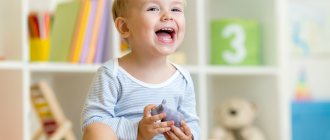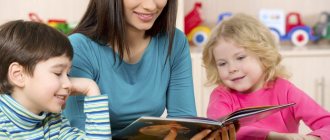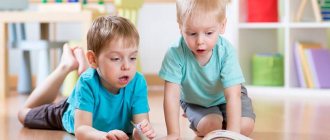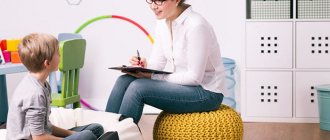Sensory alalia is a disorder in which a child’s speech does not develop due to a lack of understanding of the words of others.
This is a characteristic manifestation of disturbances in the functioning of the speech-hearing analyzer. As a result of a perinatal or postnatal complication, there is underdevelopment of some areas of the brain responsible for the perception and analysis of spoken speech.
With sensory alalia in children, in most cases, complete preservation of hearing is observed. Speech development does not occur due to the lack of connection between the sounds that the child hears and their meaning.
Symptoms of sensory alalia
The sensory alalik is not at all silent. Children have active—sometimes even overly—expressive speech. However, at the same time, they are absolutely not critical of their statements, not understanding themselves what exactly they are saying.
Characteristic features of sensory alalia:
- The mindless repetition of frequently heard phrases is echolalia. The child may persistently repeat advertising slogans, words of cartoon characters, etc. Sometimes speech may seem meaningful if the child repeats the last word he heard along with the answer. But if you change the phrase, there will be no result.
- Frequent confusion of words, syllables and phrases, the use of made-up words - the so-called logorrhea - is another characteristic symptom of sensory alalia.
- In most cases (about 70%), hearing remains intact. However, there is instability of auditory attention. In addition, many alaliks suffer from hyperacusis - increased sensitivity to certain sounds.
- Phonemic speech perception is impaired. That is, the chain through which auditory excitation is transmitted to brain structures associated with speech “does not work” in the child.
- There are also some memory impairments. In order to remember a word or phrase, alalik requires quite a lot of repetition.
So, speech with sensory alalia is absent not because the child has disorders of the auditory or speech or articulatory apparatus, but due to the inability to form a connection between the sound of a word and an object.
Sensorimotor alalia - symptoms and treatment
Children with sensorimotor alalia need systematic medical and pedagogical rehabilitation [16].
Classes with a speech therapist and defectologist are primarily prescribed not for speech development, but for teaching the child to follow simple everyday instructions. The patient is also taught simple concepts (shape, size, primary colors), taught to group animals, vegetables/fruits, furniture, transport, etc. Then, with the help of visual aids (cards), they begin to form a vocabulary - memorize the names of objects, animals, food products [3][20].
As basic knowledge is mastered, the specialist teaches the child first to pronounce sounds and then simple words. For this, the following can be used: rehabilitation and developmental methods of Doman, PECS cards, onomatopoeia for animals (how a cow mooes, how a cat meows, etc.).
Also, for the rehabilitation of patients with sensorimotor alalia, they resort to classes in an audio simulator, speech therapy massage, microcurrent reflexology, neurocorrection and drug therapy.
During classes in the audio simulator, special bone conduction headphones are used, which allow the child to isolate his own voice from the general noise of the environment. Special speech filters make the child’s voice sonorous, rich and louder than all other surrounding sounds, which attracts his attention. The child develops an interest in pronouncing sounds and words with a speech therapist and consciously controlling his speech [11][20].
Speech therapy massage is a massage of the speech muscles involved in pronouncing sounds using speech therapy metal probes. This method allows you to restore the impaired tone of the articulatory muscles and activate the speech zones of the cerebral cortex due to ascending sensory impulses from the receptors of the skin and mucous membrane of the face and mouth. Speech therapy massage also helps improve blood supply and restore innervation of the muscles of the speech apparatus. Logo massage is necessary for non-speaking children, children with impaired diction, drooling and a slightly open mouth, since all of them do not know how to control their organs of articulation [13][20].
Microcurrent reflexology is recommended by the Ministry of Health of the Russian Federation to improve speech function in children with developmental delays. During the procedure, the doctor applies electrodes through which ultra-small electrical impulses pass to various areas of the patient’s skin. Under the influence of these impulses, normal reflex activity of the nervous system is restored. They improve blood circulation and activate various areas of the cerebral cortex. For the child, this procedure is painless, the treatment regimen is drawn up individually [2][18][19][22][23].
With sensorimotor alalia, various speech areas of the brain are activated:
- Wernicke's area - for the development of the function of speech understanding, the acquisition of passive vocabulary;
- Broca's area - to increase the desire to engage in verbal contact, replenish active vocabulary;
- associative zones of speech - to develop the skill of composing phrases and sentences;
- motor zones that control articulatory muscles - to normalize diction.
Microcurrent reflexology can also improve the functioning of the frontal lobes of the brain. This contributes to the formation of social and everyday skills. If necessary, sedative treatment regimens are used to reduce excitability. The procedures are carried out with EEG control [7][14][15].
Neurocorrection is aimed at restoring the stages of brain development. Neuropsychology classes involve performing exercises with special equipment: tabletop labyrinth simulators for interhemispheric interaction, a balance board for cerebellar stimulation, a pendulum ball, a floor target, number figures and massage bumps. The classes are aimed at improving the interaction of the two hemispheres of the brain, restoring conscious control over one’s behavior and consciously acquiring complex skills [4][16].
To restore the damaged nervous system, pediatric neurologists often prescribe drug therapy . Thus, to eliminate the consequences of hypoxia, as a rule, drugs with an antioxidant effect are indicated: cortexin, cytoflavin, etc. In cases where a child has destruction (thinning) of the white matter due to hydrocephalus, drugs are prescribed that help restore the sheaths of nerve fibers : cerakson, nucleo CMP, B vitamins, as well as lecithin, which contains phospholipids - a building material for cell membranes. For external hydrocephalus, diuretics (diacarb) or herbs with a diuretic effect are indicated [1][7][9][15][19].
It is important to remember that medications do not improve the functioning of a specific language area of the brain - they can improve the functioning of the brain as a whole. Any medications should be prescribed only by a neurologist; self-medication is unacceptable.
Correction of sensory alalia
Classes to correct this condition are structured depending on its severity. A severe form of alalia, resulting from significant damage to areas of the brain, the child is completely unable to analyze sounds and, accordingly, understand the surrounding speech. A lighter state allows children to be aware of individual words, but not to isolate them in phrasal speech or, conversely, to perceive situationally remembered sentences and not understand words used independently.
To correct sensory alalia, a speech therapist must conduct an examination to correctly determine the severity of the condition and build a lesson plan that includes the necessary exercises and tasks.
Severe forms of this condition can lead to secondary mental and intellectual development disorders, so it is important to find a specialist who will help the child develop his speech.
Causes and symptoms of alalia in children
The causes of the disease lie in the characteristics of intrauterine or early (up to three years) development of the child:
- Fetal hypoxia or asphyxia of the newborn.
- Intrauterine infection of the fetus leading to organic brain damage.
- Traumatization of the expectant mother (falls, blows to the stomach).
- Severe diseases of a pregnant woman of a chronic nature.
- Any pathologies of delivery, including intracranial trauma of the child.
- In the first years of life, the child suffered severe and/or long-term illnesses and surgery with general anesthesia.
An unfavorable family environment and unsatisfactory social conditions aggravate the harm caused by the main etiological factors.
Alalia symptoms:
- Motor alalia - impaired coordination of movements and motor skills, memory, hyperactivity or retardation, fatigue. Speech practically does not develop or develops with a great delay, slowly, with disturbances, the vocabulary is limited, the child uses short sentences. Due to speech dysfunction, intellectual development gradually begins to suffer.
- Sensory alalia - the child does not speak, but tries very hard, reproduces sounds and sound combinations that do not make sense. For the purpose of communication, the child actively uses facial expressions and gestures. Violation of the processes of speech development causes deviations in behavior, lag in intellectual development, and mental deviations may begin.
Statistics show that alalia in its pure form is not common. A predominantly sensorimotor form of pathology is diagnosed.
Tasks and exercises for sensory alalia
Speech therapy classes are conducted as part of complex therapy. At the same time, given that the violation is systemic in nature, work is being carried out “on all fronts.” The classes necessarily include exercises for the development of motor skills, attention, memory, and phonemic hearing.
It is important to consider that for children with sensory alalia, uncontrolled sound sources only slow down the correction process, overloading the psyche and not having any speech impact. Therefore, the first thing the specialist recommends is organizing regular “quiet time” in the family and generally limiting the sound environment. Against such a depleted sound background, the child’s sensitivity to speech increases. This state is used during classes.
Corrective measures for motor alalia
The main principle of speech therapy work for alalia is consistency. It is necessary to help the child by developing the mechanism of his speech activity. Motivation, interest in classes, and the desire to communicate set the child up to remember the material. To facilitate the development of lexical and grammatical means of the language, the work is structured according to the following stages:
- Speech activity is fostered. Passive and active dictionaries are replenished. Words are selected in accordance with the age and capabilities of the child. He is taught the skills of constructing dialogue in various situations.
- The dictionary becomes more complex, phrasal statements are formed, and work is carried out on their structure. Dialogues and stories become more detailed and descriptive.
- The formation of coherent speech continues. The construction of grammatical structures is gradually brought to automaticity.
Each stage of speech therapy work for motor alalia is based on involving the little patient in communication. At the same time, tasks are given to develop fine motor skills. Classes are supported by colorful visual materials, pictures, and toys. The patience of the speech therapist allows you to establish good contact, which greatly helps in the acquisition of speech skills.
Diagnostics
To diagnose alalia, consultation with doctors such as a neurologist, pediatrician, otolaryngologist, and psychologist is necessary. In rare cases, a visit to a neurosurgeon is required. Consultation helps to identify the peculiarities of the child’s speech development.
First of all, anamnesis is collected, including standard questions about the condition of the mother during pregnancy and the child. Differential diagnosis is also necessary in order to exclude other diseases of the speech apparatus.
To identify brain damage, you will need to conduct one of the studies, for example: EEG, X-ray, MRI, echoencephalography.
If a child is diagnosed with sensory alalia, it is necessary to exclude hearing loss. For this purpose, otoscopy, audiometry and some other studies are performed.
Causes
The causes of alalia in children are associated with brain damage. This can occur both during intrauterine development and in the first year of a child’s life, when the brain is being formed, which means its structures may be susceptible to pathological effects.
During pregnancy, brain development can be affected by various intrauterine infections, chronic fetal hypoxia, uteroplacental insufficiency, smoking and maternal alcohol abuse. Damage to the baby's brain can also occur during childbirth. At this time, brain damage is associated with the development of acute hypoxia in the newborn. This can occur with prolonged standing of the baby's head in the pelvis, early rupture of amniotic fluid, weakness of labor, rapid labor, entanglement of the umbilical cord around the baby's neck, birth trauma, hypothermia of the baby and lack of nutrients in the first hours after birth. In the first year of a child’s life, brain damage is possible due to severe viral infections (meningo-encephalitis, rubella), traumatic brain damage (bruises, closed craniocerebral injuries).








